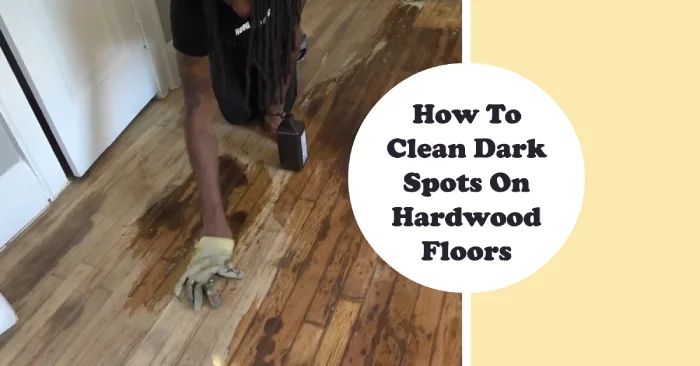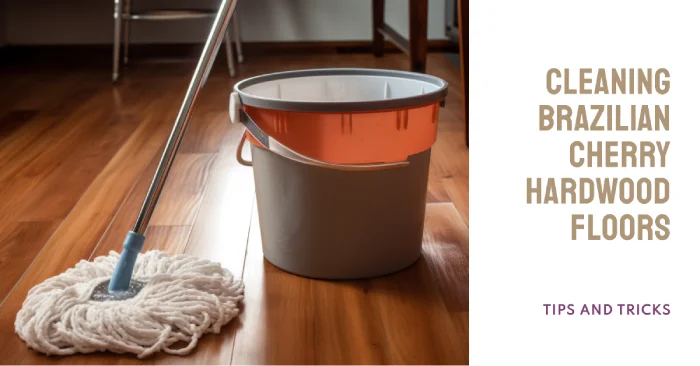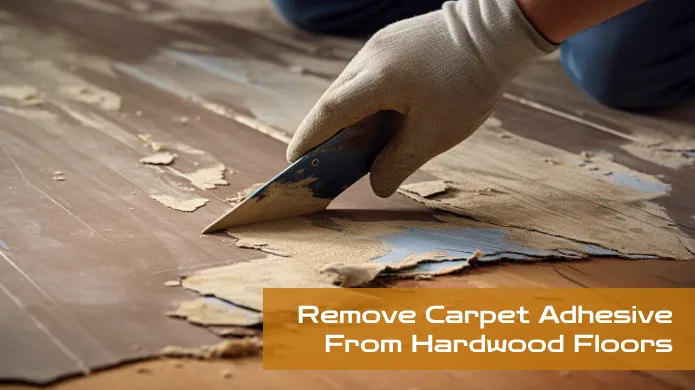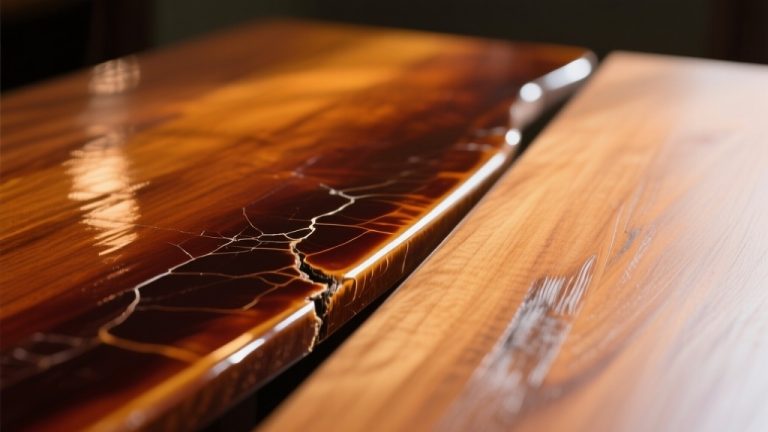How to Clean Dark Spots on Hardwood Floors: 5 Methods [Effective]
Hardwood floors add beauty and warmth to any home. But, over time, they can develop dark spots that make them look dull and unattractive. There are several ways to clean those unsightly spots and have your floors look as good as new.
You can clean dark spots on hardwood floors with vinegar and water, which is very effective and affordable. Another efficient method to remove dark spots from your hardwood floors is using baking soda paste.
Hydrogen peroxide is also an excellent cleaning solution that can remove dark spots from hardwood floors. Also, there are other ways to clean hardwood floors.
Let’s go over all possible methods with detailed steps to get clean quickly, fresh-looking hardwood floors.
How to Clean Dark Spots on Hardwood Floors: Different Methods You Can Try
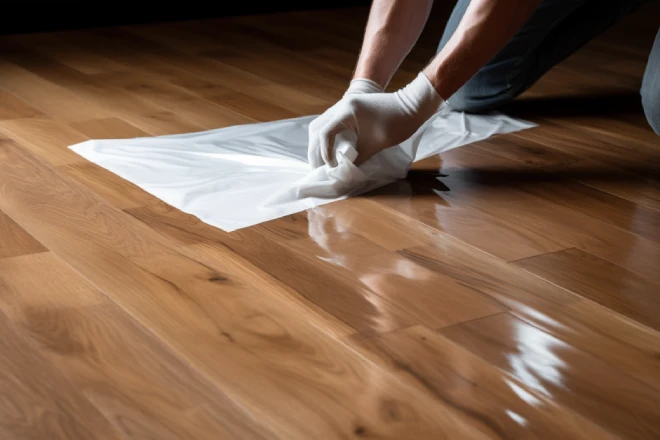
If you’re dealing with unsightly dark spots on your hardwood floors, here is a quick overview of some effective methods:
Method #1: Vinegar and Water Solution
Method #4: Sanding and Refinishing
Method #5: Commercial Hardwood Floor Cleaner
Let’s go through the steps in detail to understand each method better.
Method #1: Vinegar and Water Solution
Vinegar and water are one of the easiest and most effective methods. Mix white vinegar with warm water in a bucket to get rid of those pesky marks on your hardwood floors. Using equal parts of both liquids is crucial to ensure the best results.
Once you’ve got your solution, grab a soft cloth or mop and wring it out to remove excess liquid. You don’t want to soak your hardwood floor. Just give it a gentle scrub to remove the dark spots.
The acidity of the vinegar will work to break down the dirt and grime that caused the dark spots on your hardwood floor. Once you’ve given the area a good scrub, rinse it thoroughly and dry it.
This method is safe for cleaning hardwood floors without harsh chemicals or damaging the wood. Give it a try and see the results for yourself.
Method #2: Baking Soda Paste
With a simple baking soda paste, you can also bring back the natural beauty of your hardwood floors. This method effectively removes dark spots caused by stains, water damage, or wear and tear.
Baking soda is a natural and non-toxic cleaner that’s safe for use on hardwood floors, making it an ideal solution for those who want to avoid harsh chemicals.
To use this method, combine baking soda with a small amount of water to make a paste. Then, apply the paste to the dark spots on the hardwood floor and use a soft cloth or sponge to rub the paste into the spots gently.
Let the paste sit for a few minutes to penetrate the wood and remove the stains. In the end, wipe away the paste with a damp cloth, wash the spot with clean water, and dry it.
This method is both easy and affordable and will leave your hardwood floors looking beautiful and spotless.
Method #3: Hydrogen Peroxide
Hydrogen peroxide is a powerful yet gentle cleaning agent that can break down stubborn stains without damaging the wood. You can also easily remove unsightly blemishes with diluted hydrogen peroxide from worn and tired wooden surfaces. This method is especially effective for dark spots on hardwood floors.
Begin by diluting hydrogen peroxide with water in a 1:1 ratio. Moisten a cloth with the solution and place it on top of the dark spots. Allow it to sit for a few hours or overnight.
After the solution’s had time to work its magic, remove the cloth and wipe away any residue with a clean, damp cloth. Rinse the area with clean water and dry it thoroughly.
Your hardwood floors will look as good as new with a little patience and elbow grease.
Method #4: Commercial Hardwood Floor Cleaner
A commercial hardwood floor cleaner is a great option, specifically formulated to remove dark spots and other tough stains from hardwood floors. These cleaners, such as sprays or concentrates, come in various forms and are readily available in most hardware or home improvement stores.
To use a commercial hardwood floor cleaner, follow the instructions on the label. Generally, you’ll need to spray the cleaner directly onto the dark spots and wipe them clean with a cloth or mop. Make sure you rinse and dry the area well.
Be sure to read the label carefully and follow all safety precautions. With the right commercial hardwood floor cleaner, you can easily restore your hardwood floors’ natural beauty and keep them looking their best for years.
Method #5: Sanding and Refinishing
Now, if your hardwood floor’s dark spots are proving to be too stubborn for commercial cleaners, consider a more drastic approach.
Sanding and refinishing the affected area is effective but should only be used as a last resort. This method requires much more time, effort, and expertise than the previous ones.
To start, you’ll need to sand down the affected area to remove the top layer of the hardwood. Once you’ve removed the discoloration, apply a new stain and finish to match the rest of your hardwood floor.
You must note that professionals or those with experience should only do sanding and refinishing. Improper sanding can cause irreparable damage to your hardwood floor, leading to higher repair costs.
What Causes Dark Spots On Hardwood Floors?
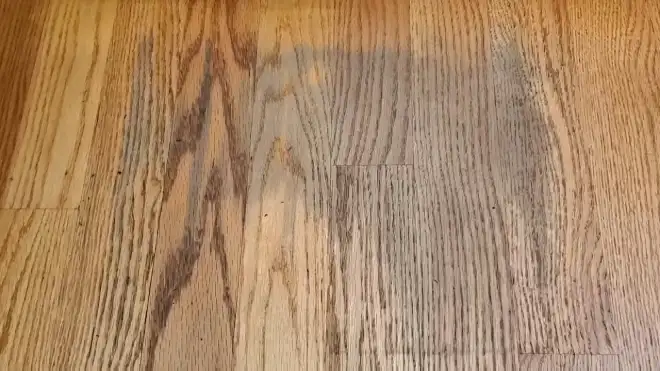
If you’re wondering why hardwood floors get dark spots, several factors can contribute to their appearance.
1. Water Damage
Your beautiful hardwood floors may be ruined forever if you don’t act fast to stop the destructive power of water damage.
When water seeps into the wood, it disintegrates the fibers and causes discoloration. The longer you wait to address the issue, the more extensive the damage will be. It’s imperative to act fast to minimize the damage.
2. Pet Urine
You may have a real problem if your pet’s accidents have left your beautiful hardwoods with unsightly stains resembling pet spots.
Pet urine can be particularly problematic, as it contains acids and other compounds that react with the wood fibers and cause discoloration. If left untreated, the urine can seep deep into the wood, making it more difficult to remove the stains.
3. Mold or Mildew
Moisture accumulation in or beneath wood can create a favorable mold and mildew growth environment, damaging your home’s beauty and health. If you notice dark spots or stains on your hardwood floor, it may be a sign of mold or mildew growth.
4. Sunlight Exposure
The UV rays in sunlight can bleach or darken the wood, leading to uneven coloration and the formation of dark spots.
It can be frustrating and disappointing when these dark spots appear, especially when you’ve invested so much time and effort in keeping your floors looking their best.
5. Chemical Spills
Chemical spills can indeed cause dark spots on hardwood floors. A chemical spill on a hardwood floor can penetrate the wood’s surface, causing discoloration and leaving behind dark spots.
The specific chemicals involved in the spill play a significant role in the severity and appearance of the dark spots. Some chemicals have stronger staining properties than others, and certain types of hardwood may react differently to various substances.
When a chemical spill happens, the liquid may seep into the wood’s pores or create a chemical reaction with the finish or stain on the floor’s surface. This penetration can lead to a chemical reaction that alters the wood’s natural color or damages the protective coating.
Over time, the affected area may darken or become discolored, resulting in noticeable spots or patches on the hardwood floor.
6. Natural Aging and Wear
As you walk across your beloved floors day after day, they slowly develop a unique character and charm that only comes from years of use and love. This natural aging and wear can also lead to the appearance of dark spots that may mar the beauty of your hardwood floors.
These spots can appear due to foot traffic, furniture movement, and general usage that gradually wears down the protective finish, exposing the wood to staining agents.
Can you use oxalic acid to clean dark spots on hardwood floors?
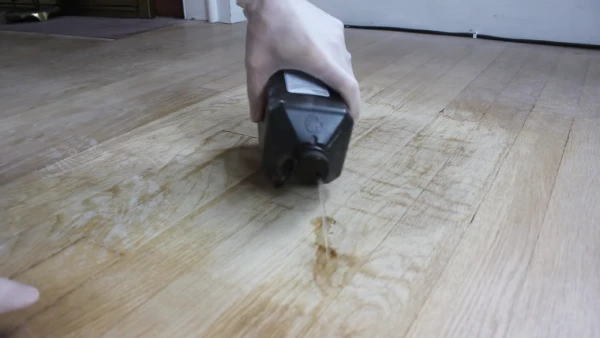
Oxalic acid works great for removing unsightly stains and discolorations from hardwood floors.
When used properly, oxalic acid can lighten or remove dark spots, giving your floors a fresh new look. Following the manufacturer’s instructions when using oxalic acid is vital, as it can be toxic if ingested or inhaled.
Before applying the acid to your hardwood floors, testing a small, inconspicuous area is recommended to ensure compatibility and avoid potential damage. Also, proper protective measures should be taken, such as wearing gloves and ensuring proper ventilation during cleaning.
Can you use bleach to clean dark spots on hardwood floors?
Using bleach on dark spots on hardwood floors is not recommended. Bleach can damage the finish and weaken the wood fibers, worsening the problem.
Also, the harsh chemicals in bleach may cause discoloration or lightening of the wood. It is best to use milder cleaning solutions specifically designed for hardwood floors.
Will ammonia damage hardwood floors?
Using ammonia on your hardwood floors can cause damage due to its alkaline properties, so you need to consider alternative cleaning solutions.
While ammonia is powerful, it can dull or scratch your hardwood floors’ finish. The ammonia can break down the protective layer, leaving it susceptible to damage.
Transform Your Hardwood Floors: Say Goodbye to Dark Spots
You now know how to clean dark spots on your hardwood floors. With the different methods, you can choose which one suits your needs and preferences.
Remember that prevention is better than cure, so always clean up spills and stains immediately to avoid dark spots and discoloration.
Think of your hardwood floors as a canvas that tells a story, with each dark spot representing a chapter. Cleaning those dark spots is like erasing unwanted lines on a painting, revealing the beauty and clarity of the image.
With proper maintenance and care, your hardwood floors will look gorgeous and last long. So go ahead and try these methods out, and let your floors shine like the masterpiece they’re.

